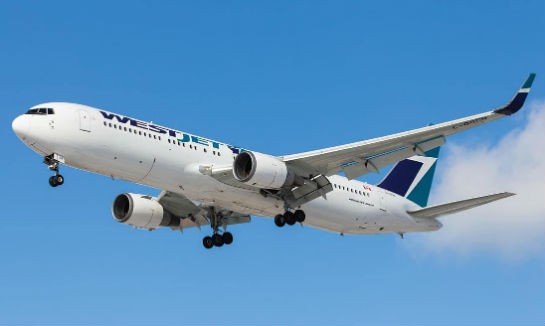Estimated reading time 6 minutes, 21 seconds.
WestJet obtained four used 767-300s to serve international routes, including London’s Gatwick Airport. Galen Burrows Photo
For Canada’s two largest airlines, the highlight of 2016 has been the growth in their international routes.
In May, WestJet Airlines Ltd. launched its long-awaited service from six Canadian cities to London’s Gatwick Airport, deploying Boeing 767s. At Air Canada, the arrival of more Boeing 787 Dreamliners is allowing the carrier to add long-haul routes while its Rouge leisure unit flies with 767s (overseas) and Airbus A319s and A320s (North America and sun destinations).
Back in 2005, Air Canada placed its orders for new 787s while WestJet mused about offering transatlantic service.
WestJet now provides flights to Gatwick Airport from Vancouver, Calgary, Edmonton, Winnipeg, Toronto and St. John’s. The airline began the St. John’s-Dublin route in 2014 and started Halifax-Glasgow in 2015, but London has been the prize eyed for years.
Founded in 1996, WestJet’s fleet has expanded well beyond the older 737s, transitioning to newer models and obtaining four used 767-300s.
“From humble beginnings as a regional airline serving five destinations in Western Canada, we have grown to become a truly international carrier in just two decades,” WestJet chief executive officer Gregg Saretsky said in a statement.
WestJet is scheduled to start taking delivery of the narrow-body Boeing 737 MAX in 2017, but it remains to be seen whether the wide-body Boeing 787 will join its fleet in future. Earlier this year, Saretsky told industry analysts that it is more cost-effective to have four Boeing 767s, given low prices for jet fuel, versus the high capital costs in ordering new Dreamliners.
Robert Kokonis, president of airline consulting firm AirTrav Inc., said WestJet’s purchase of used 767s allows the carrier to deploy aircraft that are attractive to operate, given relatively low fuel prices.
“It buys WestJet some time. It enables them to dip their toes in the transatlantic market,” Kokonis said. “WestJet wants to see how well it will be doing on the transatlantic market before committing to making a decision on what fleet they would like to acquire beyond the 767s.”
Assuming WestJet is able to keep costs per available seat mile under control while having healthy revenue, there won’t be pressure to consider 787s, he said.
WestJet’s regional Encore unit, which has Bombardier Q400 turboprops, began service in March to Boston–the first U.S. destination for Encore. Encore added the Toronto-Nashville route in June.
Air Canada and WestJet compete on some routes such as those to Hawaii, the continental United States, sun destinations and the London area.
Calgary-based WestJet does not fly to Asia, as Canadian Airlines International (CAI) formerly did. In 2000, Montreal-based Air Canada acquired cash-strapped CAI and inherited its coveted Asian routes.
Today, Air Canada has its Rouge leisure division, which launched in 2013. Through Rouge, Air Canada recently started seasonal service on Boeing 767s from Toronto’s Pearson International Airport to Prague, Budapest, Glasgow and Warsaw. From Vancouver International Airport, Air Canada’s mainline began service on the Boeing 787 in June to Brisbane, Australia, while Rouge started seasonal service on the Boeing 767 to Dublin.
In October, Air Canada will launch its seasonal Vancouver-Delhi service on the mainline’s Dreamliner aircraft. The new routes come after a busy 2015, when flights added included Toronto-Delhi and Toronto-Dubai at the mainline, and Vancouver-Osaka and Montreal-Venice at Rouge.
Duncan Bureau, Air Canada’s vice-president of global sales, said another growth area is Vancouver to London’s Heathrow Airport. Air Canada’s mainline added an extra flight seasonally so that there is double daily service from June 1 to late September on the 787 on the Vancouver-Heathrow route. Rouge launched Toronto-Gatwick service in May on the 767.
“For us, London Heathrow is still a very strategic market–much higher yield than Gatwick,” Bureau said in an interview.
He said the retrofitted Boeing 777s have helped increase Air Canada’s appeal to executive travellers. “We think our business-class product is one of the best in the world,” Bureau said.
Air Canada faces competition from a variety of foreign carriers, but Bureau said having the Maple Leaf is an advantage on aircraft in the international marketplace. “We’re representing not only our company, but also our country,” he said.
While international expansion has been hailed as a sign of strength by executives at the two carriers, some analysts have raised caution flags.
Passenger revenue per available seat mile has been reasonably firm on Air Canada’s Atlantic and Pacific routes, said Ben Cherniavsky, an analyst at Raymond James Ltd. “We expect pressure to mount in these markets as Air Canada’s capacity accelerates this summer and competition heats up,” he wrote in a research note.
He noted that WestJet has incurred expenses on new route developments, notably on launching service to Britain.
WestJet and Air Canada have been hurt by lower demand in Alberta due to the economic pain from low oil prices.
But Kevin Howlett, Air Canada’s senior vice-president of regional markets, said British Columbia’s buoyant economy has helped domestically and internationally, while Alberta will recover. “Calgary and Edmonton will come back,” said Howlett.

